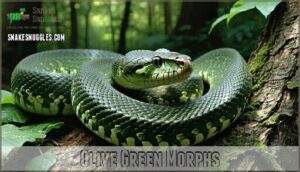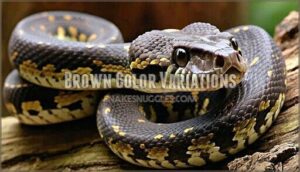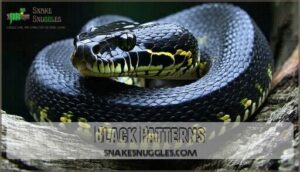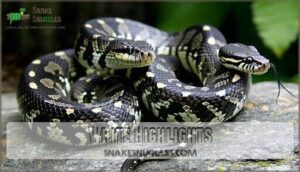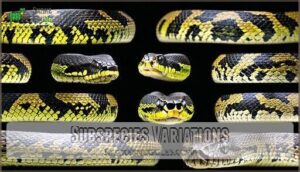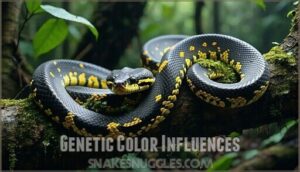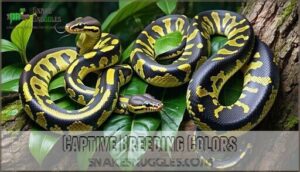This site is supported by our readers. We may earn a commission, at no cost to you, if you purchase through links.
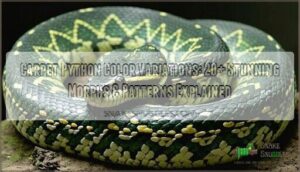 You’ll discover carpet python color variations range from rich olive greens and earthy browns to deep blacks, each accented with stunning cream, white, or gold patterns.
You’ll discover carpet python color variations range from rich olive greens and earthy browns to deep blacks, each accented with stunning cream, white, or gold patterns.
These striking snakes showcase diamond shapes, bands, rings, and intricate stripes that make each individual unique.
Regional subspecies like Jungle Carpets display vibrant yellows and blacks, while Diamond Pythons feature bold geometric patterns.
Captive breeding has opened up even more spectacular morphs, creating everything from high-contrast specimens to subtle earth-toned beauties.
The genetic lottery that determines these colors involves complex inheritance patterns that breeders have learned to predict and enhance over generations, resulting in a wide range of unique and stunning carpet python color variations, including rich olive greens and stunning cream patterns, which are key to their unique individuality.
Table Of Contents
- Key Takeaways
- Carpet Python Colors
- Regional Color Patterns
- Subspecies Variations
- Genetic Color Influences
- Captive Breeding Colors
- Frequently Asked Questions (FAQs)
- How many types of carpet pythons are there?
- What is the most docile carpet python?
- Which carpet python gets the biggest?
- Can I keep two carpet pythons together?
- How do carpet python colors change with age?
- What causes unusual carpet python color mutations?
- Do male and female carpet pythons differ in coloration?
- How does temperature affect carpet python color development?
- Can carpet python colors indicate health problems?
- Conclusion
Key Takeaways
- You’ll find carpet pythons display incredible color diversity ranging from olive greens and browns to deep blacks, all enhanced by striking cream, white, or gold accent patterns that make each snake unique.
- Regional subspecies create distinct appearances – Jungle Carpets showcase vibrant yellow and black bands, while Diamond Pythons feature bold geometric patterns that reflect their specific geographic origins.
- Captive breeding programs have expanded color possibilities beyond wild variations, producing designer morphs with enhanced contrasts, reduced patterns, and completely new color combinations through selective genetic pairing.
- Understanding color genetics helps you predict offspring patterns, as genes control everything from earth tone intensity to the striking black-and-yellow contrasts seen in popular morphs.
Carpet Python Colors
You’ll discover that carpet pythons showcase an incredible spectrum of colors, from deep olive greens and rich browns to striking blacks with brilliant white accents.
Carpet pythons paint nature’s most stunning canvas with their mesmerizing spectrum of earth tones and bold contrasts.
These natural color variations create some of the most beautiful patterns in the snake world, with each individual displaying unique combinations that make them truly enchanting pets.
Olive Green Morphs
You’ll discover olive green morphs showcase nature’s perfect camouflage benefits through habitat influence and diet effects.
These carpet python colors result from olive genetics that breeding programs carefully select.
Olive carpet pythons blend seamlessly with forest environments, making them highly sought-after carpet python morphs.
Their muted green tones vary from pale sage to deep forest shades, demonstrating how carpet python genetics create stunning natural variations with perfect adaptation.
Brown Color Variations
Brown carpet python morphs showcase rich earth tones that range from light chocolate to deep mahogany shades.
You’ll notice light brown variations often display cream undertones, while dark brown specimens feature intense coffee-colored backgrounds.
Patterned browns create stunning contrasts when combined with lighter highlights, and brown intensity varies markedly between subspecies and individual snakes, showcasing a range of earth tones.
Black Patterns
When black pigmentation dominates a carpet python’s scales, you’ll witness nature’s masterpiece of melanin production creating striking visual effects.
When melanin takes control, your carpet python transforms into a living shadow with mesmerizing dark beauty.
Black intensity varies substantially across different carpet python locality populations, with some specimens showing deep obsidian tones.
Here are five key black pattern characteristics:
- Scale Pigmentation – Individual scales contain concentrated melanin cells
- Pattern Density – Black markings range from sparse dots to solid bands
- Nocturnal Camouflage – Dark patterns help pythons blend with shadows
- Regional Variations – Coastal populations often display darker morphs
- Genetic Expression – Multiple genes control black color variations in carpet snake variations
Some axanthic morphs showcase striking black and silver coloration due to the lack of yellow pigment, a key identifier when considering carpet python morphs.
White Highlights
The white highlights in carpet pythons create stunning contrasts against darker base colors.
These cream, white, or gold accents appear as diamond centers, stripe borders, or scattered scales throughout the pattern.
| White Highlight Type | Common Locations |
|---|---|
| Diamond Centers | Body segments, vertebral line |
| Stripe Borders | Pattern edges, scale margins |
| Scattered Accents | Random scales, head markings |
| Cream Undertones | Belly scales, throat area |
Scale pigmentation determines highlight intensity, while color genetics control albino influence and leucism effects in reptile color morphs.
Regional Color Patterns
Although carpet python coloration varies dramatically across Australia, geography plays the starring role in determining these stunning patterns.
Northern populations in Queensland showcase pale yellow to rich gold backgrounds with bold black bands, creating high contrast that helps reflect heat in tropical climates.
Southern forms take a different approach, displaying muted olive and chocolate tones that blend perfectly with cooler forest environments.
Arid zone carpet pythons develop sandy gray backgrounds with faded patterns, while coastal populations maintain vibrant yellows and strong black markings.
This habitat influence extends beyond simple camouflage needs – altitude impact and geographic isolation create unique local variations.
Diamond python colors shift from bright contrasts in rainforests to subdued earth tones in dry regions.
As with rat snakes, camouflage aids survival, demonstrating how carpet python breeding populations adapt their appearance to match specific environmental demands, proving that nature’s paintbrush responds directly to landscape pressures.
Subspecies Variations
You’ll discover significant color differences between carpet python subspecies that make identification straightforward.
Each subspecies has evolved distinct patterns and colors based on their geographic origins, from the high-contrast bands of Jungle Carpet Pythons to the diamond patterns of their eastern relatives.
Jungle Carpet Pythons
Nothing beats the jungle carpet python‘s striking high-contrast banding that captivates reptile enthusiasts worldwide.
These Australian natives showcase nature’s most dramatic carpet python color combinations through selective captive breeding programs.
- Bold black and yellow stripes create stunning visual impact
- Intensified color intensity from generations of careful carpet python breeding
- Rainforest pattern origins reflect their northeastern Queensland habitat
- Calm temperament traits make them popular pets despite vivid appearance
- Leaner body structure distinguishes them from bulkier carpet python subspecies
Owners can find essential care products for them online.
Diamond Pythons
Diamond patterns stand out as nature’s masterpiece in carpet python design.
You’ll notice these stunning snakes display dark bodies with cream to yellow diamond-shaped markings that create incredible scale iridescence.
Their habitat influence from cool coastal regions produces glossy appearances.
In captive care, these carpet colors remain vibrant, making diamond carpet python pattern variations highly sought after in carpet styles.
Some breeders focus on specific color morphs to enhance these incredible traits.
Their efforts lead to a wide range of carpet python designs, showcasing the beauty of nature’s masterpiece.
Irian Jaya Pythons
Moving from Australia’s diamond-patterned beauties, you’ll find Irian Jaya pythons showcase stunning earth tones across New Guinea’s landscapes.
Their captive morphs display remarkable color intensity through distinctive banding patterns that make carpet python pattern identification straightforward.
Many enthusiasts seek Irian Jaya products to celebrate this species.
Their unique carpet colors include:
- Golden bronze bases that shimmer like sunset
- Irregular chocolate bands creating natural carpet textures
- Lighter crown markings distinguishing them from other carpet styles
- Variable head patterns showcasing nature’s artistic carpet design
Coastal Pythons
You’ll find coastal carpet pythons showcase olive brown to tan coloration with subtle pattern boundaries.
Their mcdowelli traits make them the largest subspecies, often exceeding 8.5 feet.
Their geographic distribution spans Australia’s eastern coast, where habitat preferences include diverse environments.
Size differences are notable compared to other subspecies, and their conservation status remains stable for this coastal carpet python variety.
Genetic Color Influences
Understanding genetic influences helps you predict which colors your carpet python offspring might display.
You’ll find that genes control everything from the intensity of earth tones like tan and orange to the striking contrast between black and yellow patterns seen in jungle morphs.
Earth Tones
You’ll notice that natural camouflage drives earth tone development in carpet pythons.
These earthy pigments create stylish colors ranging from browns and olives to sandy tans.
Color genetics behind these carpet options involve MC1R genes controlling melanin distribution for ideal habitat blending.
Regional variations show consistent earth-toned patterns across dry woodland populations, with heterozygous individuals displaying beautiful gradient shifts between different carpet color morphs.
Understanding how dominant genes show traits is vital for predicting these color variations.
Bright Color Contrasts
While earth tones provide natural camouflage, some carpet pythons showcase striking bright color contrasts that make them stand out like living artwork.
These vibrant patterns result from specific genetic markers affecting color intensity and pattern sharpness in captive lineages.
- Jungle carpet pythons display high-contrast black and yellow banding through codominant alleles
- Caramel carpet python morphs show enhanced golden hues with sharp pattern definition
- Albino carpet python varieties exhibit bright yellows and whites with reduced melanin
- Visual perception studies reveal these contrasts aid in mate selection behaviors
- Axanthic carpet python forms create blue-gray contrasts by removing yellow pigments
Dark Color Morphs
Dark melanin becomes nature’s blueprint for survival, creating stunning black-backed morphs in carpet pythons.
You’ll find melanistic variants result from increased eumelanin production, while hypermelanistic alleles amplify black markings.
These dark color morphs offer thermal regulation benefits through solar absorption and enhanced camouflage benefits in shadowy habitats.
Genetic dominance patterns guarantee consistent transfer across generations in pure breeding lines.
Captive Breeding Colors
You’ll discover that captive breeding has revealed incredible color possibilities beyond what nature originally provided.
Selective breeding programs have produced morphs with enhanced yellows, reduced patterns, and completely new color combinations that would never occur in wild populations, which is a result of captive breeding.
Selective Breeding
When you’re selective breeding carpet pythons, you’re basically playing genetic matchmaker.
Breeders pair snakes with specific morph traits to produce designer morphs like the striking jaguar carpet python or granite carpet python.
By understanding dominant genes versus recessive genes, you can predict offspring patterns.
Line breeding concentrates desirable traits, creating those wow-factor snakes collectors love.
Color Morph Development
Since the 1980s, breeders have developed over 30 distinct color morphs through careful genetic selection.
Environmental factors and genetic mutations create stunning varieties like the granite carpet python’s speckled patterns and jaguar carpet python’s rosette markings.
Temperature effects during incubation can influence morph expression, while hybridization impact between subspecies like darwin carpet python and inland carpet python produces unique combinations.
Diet influence remains minimal compared to genetic factors in determining final coloration patterns.
Pattern Variations
You’ll discover countless pattern variations through selective breeding that go far beyond wildtype patterns found in nature.
Captive breeding programs create digital patterning effects, producing textured carpets of scales with unique regional markings.
Pattern frequency changes dramatically – some morphs show dense scale patterns while others display striking pattern aberrations.
Some breeders focus on morphs with grayscale coloration, similar to the axanthic ball python.
These flooring patterns of nature become living patterned carpets through careful genetic selection.
Frequently Asked Questions (FAQs)
How many types of carpet pythons are there?
You’ll find six main subspecies of carpet pythons, each with distinct patterns and colors. These include Diamond, Jungle, Coastal, Darwin, Centralian, and Irian Jaya pythons, all showcasing nature’s incredible diversity.
What is the most docile carpet python?
Roughly 80% of carpet python temperament depends on individual genetics rather than subspecies.
You’ll find Diamond Pythons (Morelia spilota spilota) consistently rank as the most docile, with their calm nature making them ideal beginner snakes.
Which carpet python gets the biggest?
Coastal Carpet Pythons reach the largest size among subspecies, with you potentially encountering specimens stretching 9-13 feet long.
These Australian giants pack serious length compared to their smaller Diamond or Jungle cousins, making them notable for their size.
Can I keep two carpet pythons together?
Jake’s two carpet pythons shared a tank for months until territorial disputes led to stress and feeding problems.
You shouldn’t house carpet pythons together—they’re solitary animals that compete for resources and space, causing aggression and health issues.
How do carpet python colors change with age?
Young carpet pythons typically display duller, more muted colors that gradually intensify and brighten as they mature.
You’ll notice their patterns become more defined and vibrant over their first few years of life.
What causes unusual carpet python color mutations?
Surprisingly, you’d think genetics alone controls carpet python colors, but environmental factors like temperature, humidity, and stress actually trigger genetic mutations.
Breeding programs selectively enhance these natural variations through careful genetic manipulation.
Do male and female carpet pythons differ in coloration?
Male and female carpet pythons don’t show significant color differences.
You’ll notice that both sexes display the same range of patterns and hues within their subspecies, with individual variation being more important than gender in determining coloration.
How does temperature affect carpet python color development?
Like a chameleon shifting with its surroundings, temperature plays a pivotal role in your carpet python’s color development.
Cooler incubation temperatures typically produce darker, more vibrant patterns, while warmer conditions create lighter, more muted coloration.
Can carpet python colors indicate health problems?
You can spot potential health issues through color changes in your carpet python.
Dull, faded colors often signal stress, dehydration, or illness, while unusually dark patches might indicate infections or parasites affecting their vibrant patterns.
Conclusion
Through nature’s artistic lens, carpet python color variations paint a living masterpiece across scales and patterns.
You’ve explored how genetics weave together olive greens, rich browns, and striking blacks with cream highlights to create unique individuals.
Whether you’re drawn to Jungle Carpet‘s vibrant yellows or Diamond Python‘s geometric precision, each snake tells its own colorful story.
Understanding these variations helps you appreciate the remarkable diversity within this single species.
- https://backyardbuddies.org.au/backyard-buddies/carpet-python/
- https://aussieanimals.com/reptiles/snakes/carpet-python-guide/
- https://herpetoculturenetwork.com/morelia-spotlight-papuan-carpet-pythons/
- https://exoticskeeper.com/blog/much-morelia-than-meets-the-eye/
- https://www.aussiepythons.com/threads/south-west-carpet-python-colour-variations.217968/

